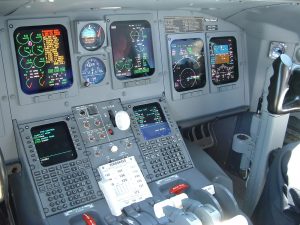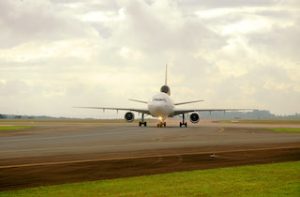Aviation Training With AI, Technology, And Google
 The aviation industry is one of the most safety-conscious and technologically advanced sectors globally. As the demand for air travel continues to rise, airlines must adapt to ensure they have a steady supply of skilled, competent pilots who are ready to operate in increasingly complex flight environments. To meet this demand, airline pilot training solutions have evolved, incorporating the latest advancements in technology, simulation, and digital tools, with Google playing a key role in reshaping the way pilots are trained.
The aviation industry is one of the most safety-conscious and technologically advanced sectors globally. As the demand for air travel continues to rise, airlines must adapt to ensure they have a steady supply of skilled, competent pilots who are ready to operate in increasingly complex flight environments. To meet this demand, airline pilot training solutions have evolved, incorporating the latest advancements in technology, simulation, and digital tools, with Google playing a key role in reshaping the way pilots are trained.
In this article, we will explore the cutting-edge airline pilot training solutions that are shaping the future of aviation. We will delve into how AI, cloud-based technologies, and innovations from Google and other tech leaders are revolutionising pilot education, enhancing safety protocols, improving learning outcomes, and ultimately preparing the next generation of pilots for the challenges of modern air travel.
Changing landscape with Google
Historically, pilot training has been a lengthy, costly, and resource-intensive process, primarily relying on traditional methods such as classroom instruction, flight simulators, and hands-on training in actual aircraft. While these methods remain crucial for building a foundation of knowledge and experience, technological advancements have transformed the industry and how training programs are delivered.
1) Rise of simulation-based training
The most significant development in airline pilot training has been the widespread adoption of flight simulators. Simulators replicate the experience of flying an aircraft without the risk and cost of live flight operations, allowing trainees to practice critical skills, handle emergencies, and understand complex flight maneuvers. This innovation has drastically reduced the training time required for pilots, while also offering the opportunity to learn in a safe, controlled environment.
Virtual reality and augmented reality in training
In recent years, virtual reality and augmented reality have become increasingly popular in pilot training. Using immersive VR technology, trainees can experience realistic flight scenarios in a virtual environment, which helps them develop muscle memory, spatial awareness, and the ability to manage flight stressors.
Google’s Cardboard and Daydream VR platforms are examples of VR tools that have been adapted for use in pilot training. By integrating VR simulations into training programs, pilots can perform repeated exercises and emergency drills, gaining proficiency without leaving the ground. Moreover, VR technology is cost-effective compared to traditional training methods, making it a valuable tool for airlines looking to reduce overhead costs.
AR is also gaining traction in training, especially in aircraft maintenance and pre-flight check procedures. Google’s ARCore enables developers to create AR applications that overlay important flight information on real-world environments, improving the way pilots and maintenance staff interact with aircraft and supporting faster, more efficient training sessions.
2) AI-powered training solutions
Artificial intelligence is another technological advancement that has significantly improved pilot training. AI systems can simulate complex flight conditions, analyze vast amounts of data in real-time, and provide real-time feedback to trainees. These systems are becoming smarter, learning from each interaction to offer more personalized and effective training experiences.
AI-powered platforms can monitor a trainee’s performance during simulated flights, analyzing metrics such as speed, altitude, approach angles, and decision-making patterns. Based on this data, AI systems can suggest areas for improvement, recommend additional training, and offer customised flight scenarios. Google’s TensorFlow, an open-source machine learning framework, has enabled the development of AI-driven training tools that allow pilots to receive instant feedback on their performance, reducing training time and improving overall efficiency.
Moreover, AI helps automate the administrative aspects of pilot training, such as scheduling, progress tracking, and assessment. By integrating AI into training management systems, airlines can create more streamlined and effective training programs, allowing instructors to focus on higher-level coaching and development.
3) Cloud-based pilot training solutions
Cloud-based solutions are another integral part of modern airline pilot training. Google Cloud, with its robust data storage and computing power, has transformed how airlines and training organizations manage training materials, flight data, and simulations. Cloud computing enables airlines to provide on-demand training content and real-time updates to pilots, wherever they are in the world. This is especially beneficial for airlines that operate across multiple regions and need to ensure that their pilots have access to the most up-to-date training modules and manuals.
Cloud-based platforms also make it easier for pilots to complete online training courses, participate in virtual classrooms, and access e-learning modules. This flexibility has become increasingly important in the context of the global airline industry, where pilots often have limited time for classroom-based instruction due to their demanding flight schedules.
Google’s G Suite is a tool used by aviation companies to manage pilot training and collaboration. These tools facilitate seamless communication between instructors, training staff, and pilots, allowing them to share training resources, participate in discussions, and track progress all in one integrated platform.
4) Data-driven pilot training
Another transformative trend in airline pilot training is the use of big data to improve learning outcomes. With the ability to collect vast amounts of data from flight simulators, cockpit instruments, and real-world flight data, airlines can identify trends, make data-driven decisions, and personalize training programs.
Google’s BigQuery, a powerful data analytics platform, can be utilised by airlines to process and analyse this massive amount of data quickly. By leveraging big data, airlines can create more effective training regimens based on real-world flight performance, pinpointing areas where pilots may need additional training or improvement. For example, if data indicates that certain pilots struggle with specific flight maneuvers or emergency situations, the training program can be adjusted to address these issues.
Big data can also help predict potential risks and safety concerns, allowing pilots to focus on specific scenarios during their training. This proactive approach helps create a safer, more efficient aviation ecosystem by ensuring that pilots are better prepared for unexpected challenges in the air.
5) Google in pilot training
Google’s role in shaping airline pilot training is multifaceted. While Google itself does not specifically offer pilot training programs, its range of products and platforms has significantly contributed to the development of tools that enhance aviation training.
Google cloud
As previously mentioned, Google Cloud provides scalable, cloud-based solutions that streamline the administration of pilot training programs. With its high-performance computing capabilities, Google Cloud offers airlines and training organizations the tools to host, manage, and analyze large datasets for training purposes. Cloud storage solutions also allow pilots to access training materials from any location, ensuring that learning is continuous and accessible.
Google AI and machine learning
Google’s AI-driven solutions are increasingly being utilized in aviation training systems. By leveraging machine learning platforms such as TensorFlow, Google provides a foundation for the development of AI tools used in flight simulations, real-time performance assessments, and predictive training systems. These AI solutions can help create more dynamic and adaptive training environments, where pilots can receive personalised feedback and progress at their own pace.
Google maps and geographic information systems
Google Maps and GIS technologies can also play a role in pilot training, particularly in flight planning and navigation training. Pilots can use Google Maps to gain a better understanding of geographic locations, study airport layouts, and familiarize themselves with airspace boundaries. Google’s GIS tools can be integrated into training simulators, offering pilots a realistic view of real-world flight conditions.
YouTube and Google classroom
Google’s YouTube platform has become a valuable resource for pilot training. Training videos, tutorials, and instructional content on YouTube can supplement traditional classroom instruction, giving pilots access to visual learning materials that enhance their understanding of flight procedures and techniques. Similarly, Google classroom offers a collaborative environment where pilots can engage with instructors, submit assignments, and track their progress.
6) Addressing pilot shortage with technology
As the aviation industry grapples with a global pilot shortage, innovative training solutions, including AI and cloud-based platforms, are crucial in bridging this gap. By using technology to streamline training and make it more efficient, airlines can accelerate the certification process, producing more pilots in a shorter time. This is particularly important as the demand for air travel grows, and airlines look to expand their fleets and improve their operational capacity.
By integrating AI, VR, cloud solutions, and data analytics, airlines can reduce costs, optimize training schedules, and offer more flexible training options, ensuring that they have enough qualified pilots to meet demand. In turn, these advancements help airlines maintain the high safety standards that passengers expect while simultaneously addressing industry-wide staffing challenges.
Google enhances pilot training
The future of airline pilot training is undeniably intertwined with technological innovation. From AI-driven simulations and VR training to cloud-based platforms and big data analytics, modern training solutions are revolutionizing how pilots are prepared for the skies. Google, with its extensive suite of tools and technologies, has played a crucial role in enabling these advancements, providing the infrastructure and platforms necessary to enhance the efficiency, accessibility, and effectiveness of training programs.
As the aviation industry continues to evolve, the integration of cutting-edge technology into pilot training programs will ensure that pilots are better prepared, more efficient, and capable of handling the complex challenges they face in the cockpit. By embracing these technological solutions, the airline industry is not only improving training outcomes but also contributing to a safer, more sustainable, and faster-growing aviation sector.










